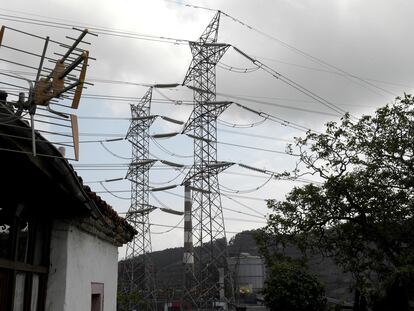Weather experts on Spain’s heatwave: ‘A summer like this will be considered cold in 30 years’ time’
Meteorologists warn that periods of extreme heat will become more intense and more frequent in the future, pointing out the number of these episodes has doubled in the past decade

Spain is experiencing its first heatwave of the year, one that will affect the Balearic Islands and almost the entire peninsula apart from Cantabria, with daytime temperatures reaching 45 degrees Celsius in Andalusia’s Guadalquivir valley and night’s with minimum’s of 26ºC to 28ºC in several parts of the country.
The soaring temperatures come three days after a report from the Intergovernmental Panel on Climate Change (IPCC), the United Nations’s panel of experts on climate change, scientifically demonstrated that human activity “has warmed the atmosphere, ocean and land,” and triggered profound changes in the climate, including rising temperatures and the proliferation of extreme weather episodes. Rubén del Campo, a spokesperson for Spain’s national weather agency Aemet, says the number of heatwaves in Spain has doubled within the space of 10 years. “Human action is increasing heatwaves in frequency and intensity. In 30 years’ time, a summer like this will be considered cold,” he says.
According to Aemet, over the next few days, thermometers will mark between 5ºC and 10ºC above average for this time of year. In some areas of the northeast and the southern half of the country, temperatures will be 10ºC above average. However, the presence of suspended dust, which can act as an umbrella and helps clouds to form, may alter the forecasts, though both daytime and nighttime temperatures will be “very high, extreme, and unusual for this time of year” in most of the peninsula, says Del Campo.
To be defined as a heatwave, a weather episode needs to meet three criteria: extreme temperatures up to 5% higher than the maximum temperatures that usually occur in summer; affecting at least 10% of the almost 800 official weather stations in Spain and lasting at least three days. “In this case, we know that the characteristics are going to be met a priori, which is why we can announce it now,” says Del Campo. “At other times, we only know it was a heatwave in retrospect, once the data has been analyzed.”
These types of episodes have doubled in just 10 years, according to AEMET data. Between the 1980s and the 2000s, there were between 10 and 12 heatwaves per decade; around one a year. In the last decade (2010-2020), there were 24. “Heatwaves have doubled in a decade with a tendency to greater frequency and intensity,” says Del Campo. “At the same time, heat records are much more frequent than they would be without climate change.”
Climatologist Dominic Royé, a professor at the University of Santiago de Compostela who has studied heatwaves in Spain, has made a projection for the future, published in the latest issue of the scientific journal Atmospheric Research. “In the three decades between 1971 and 2000, heatwaves averaged 21 days a year in Spain,” he says. “According to our projections, there will be at least 41 days a year like this by 2050, while in the worst emissions scenario we will have 50 days with extreme heat.”
Working in collaboration with Nieves Lorenzo and Alejandro Díaz-Poso, Royé adds that if in the last 30 years of the 20th century each heatwave affected, on average, 16% of the peninsula, in 2050 that will rise to between 26% and 32%.
“An exceptional heatwave”
Royé considers that the current heatwave in Spain is “exceptional” because of its unusually high maximum and minimum temperatures while the percentage of the population affected is also extensive with only the Cantabrian coast and Galicia exempt. “We will have to see afterward how to gauge the wave as, for now, it is a prediction that can change in real terms,” he says. “It remains to be seen if [dust] particles arrive from the Sahara stop all the radiation from entering, which would stop the maximum temperatures forecast from being reached.”
Hicham Acheback, from the Climate and Health group of the Barcelona Insitute for Global Health, participated in a study published in The Lancet on July 1 of this year, which found that 3,669 people died a year between 1998 and 2012 in Spain due to heat and its fallout. Based on these data and taking into account the increase in temperature, the report predicts that deaths in Spain could reach 14,531 a year between 2035 and 2064 (in the worst-case scenario, with no reduction in greenhouse gas emissions); while from 2070 to 2099 there would be 30,443 deaths (also in the worst-case scenario). However, the study does not take into account the adaptive capacity of Spaniards. “In the last 40 years, there has been an improvement in living standards and more access to air conditioning and heating, so many people are better prepared for these temperatures,” Acheback says.
Acheback explains that rising temperatures are directly related to increased mortality. “These temperatures trigger processes in our body that result in a rise in hospital admissions for cardiovascular and respiratory causes, as well as in more deaths,” he says. “The biggest impact is on the elderly as they are the most vulnerable.” To minimize this impact, Spain implemented an extreme heat alert system following a severe heatwave in 2003. The system tries to raise awareness among the population of the risks during a heatwave, asking them not to go outside during the hottest hours of the day and to drink plenty of water. “These are basic things, but very effective,” says Acheback. Some countries are setting up cooling centers, located in public facilities, so that those who do not have air conditioning at home can take shelter there during the hottest periods.
Del Campo also notes that heatwaves greatly increase the risk of wildfires. Indeed, the Interior Ministry’s General Directorate of Civil Protection and Emergencies advises the public to take maximum precaution in this respect as the country is at extreme risk of fires. Catalonia has gone further and banned activities such as youth camps in the countryside and the use of agricultural machinery between 10am and 8pm in 279 municipalities, as well as in several natural areas. Between January 1 and July 25, 2021, there were 1,959 fires in Spain, which burned 37,535.9 hectares of forest, according to the latest data from the Ministry for Ecological Transition. While this is considerably more than last year over the same period (21,132 hectares), it should be borne in mind that the 2020 figures were better due to lockdowns and restrictions on movement as a result of the coronavirus pandemic.
English version by Heather Galloway.
Tu suscripción se está usando en otro dispositivo
¿Quieres añadir otro usuario a tu suscripción?
Si continúas leyendo en este dispositivo, no se podrá leer en el otro.
FlechaTu suscripción se está usando en otro dispositivo y solo puedes acceder a EL PAÍS desde un dispositivo a la vez.
Si quieres compartir tu cuenta, cambia tu suscripción a la modalidad Premium, así podrás añadir otro usuario. Cada uno accederá con su propia cuenta de email, lo que os permitirá personalizar vuestra experiencia en EL PAÍS.
¿Tienes una suscripción de empresa? Accede aquí para contratar más cuentas.
En el caso de no saber quién está usando tu cuenta, te recomendamos cambiar tu contraseña aquí.
Si decides continuar compartiendo tu cuenta, este mensaje se mostrará en tu dispositivo y en el de la otra persona que está usando tu cuenta de forma indefinida, afectando a tu experiencia de lectura. Puedes consultar aquí los términos y condiciones de la suscripción digital.
More information
Últimas noticias
Maduro pleads not guilty before the federal court in New York: ‘I am still the president of Venezuela’
A new test can detect Alzheimer’s from a finger prick
UN team enters Sudanese city of El Fasher after paramilitary massacre: ‘It’s like a ghost town’
A recipe for resistance: Indigenous peoples politicize their struggles from the kitchen
Most viewed
- Gilles Lipovetsky: ‘If you want to live better and fall in love, take Prozac, don’t look to philosophy’
- Alain Aspect, Nobel laureate in physics: ‘Einstein was so smart that he would have had to recognize quantum entanglement’
- Alvin Hellerstein, a 92-year-old judge appointed by Bill Clinton, to preside over Maduro’s trial in New York
- Why oil has been at the center of Venezuela-US conflicts for decades
- Maduro’s downfall puts China’s relationship with Venezuela to the test










































